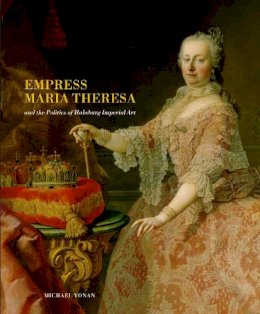Michael Yonan is Associate Professor of Art History at the University of Missouri–Columbia.
“Michael Yonan’s Empress Maria Theresa and the Politics of Habsburg Imperial Art contributes significantly to scholarship on Maria Theresa and the Habsburg Empire in particular, and to eighteenth-century studies and art history in general. Yonan deftly explores a number of paintings and architectural spaces as points of departure for understanding the construction of Maria Theresa’s complicated and often conflicting imperial identity. He compellingly demonstrates the importance of visual and material culture in promulgating and communicating notions about gender and positions of power.” —Julie-Anne Plax, University of Arizona “Michael Yonan's Empress Maria Theresa and the Politics of Habsburg Imperial Art illuminates not only the complexities of Habsburg patronage and politics but also the particular challenges faced by a female ruler. The author's astute analyses of royal portraits, palace architecture, decoration, and garden design, together with insightful interpretations of the exotic, literary, and classical iconography of her commissions, reveal how Maria Theresa shaped her complex, multidimensional identity as a powerful sovereign, mother, wife, and widow. This engaging and beautifully illustrated volume is an essential source for all future studies of the Habsburg empress and an outstanding contribution to our understanding of eighteenth-century monarchs, visual culture, and gender.” —Wendy Wassyng Roworth, University of Rhode Island “This is a most welcome study of Viennese imperial cultural politics under the exceptional reign of Empress Maria Theresa (1717–80), who for the longest time has been underestimated in almost every respect: as ruler, as art patron, and as an individual who used her intellectual and intuitive acuity to analyze and shape the gendered cultural politics of her day. Yonan addresses each of these areas, interweaving them with his account of Schönbrunn Palace, its art and architecture, interior decoration, and park. His central focus on this palace and the empress as its author offers a refreshing and convincing alternative model to the traditional one-sided, if indisputable, image of Maria Theresa as a supreme strategist in the art of marriage politics who placed her numerous offspring in the royal and electoral courts of Europe. “Yonan’s superbly illustrated book is the first to examine the full and astounding range of Maria Theresa’s patronage of all the courtly arts of her day as a complex, subtle, and effective means of representing her rulership. The palace’s interior structure and decorations, while maintaining the link to ancient Rome, are cognizant of the Austro-Hungarian crown lands’ multiethnicity, mythologize the Habsburg Empire’s historically contentious relationship with the Ottoman Empire, and orientalize the empires of the Far East. In all of these undertakings—the decoupaged Mughal paintings of the Millionen-Zimmer, the Vieux-Laque Zimmer’s chinoiserie framing Pompeo Batoni’s Roman portraits of Emperor Franz Stephan and their sons, the park’s allusions to sybilline wisdom and mourning, and the preservation of Franz Stephan’s palatial spaces—Maria Theresa, ostensibly the devoted sovereign widow and mother, never challenging masculine dynastic succession, forged a calculated amalgamation of intimacy and authority, private withdrawal and public display, Orient and Rome, into a powerful imperial identity entirely her own. This identity, subtly diffused throughout Schönbrunn’s imperial art, is also carefully charted and controlled in the state portraits of Maria Theresa as queen of Hungary, imperial spouse, mother, widow, art lover, and in oriental costume, yet never primarily as empress.” —Christiane Hertel, Bryn Mawr College “Michael Yonan’s Empress Maria Theresa and the Politics of Habsburg Imperial Art is a groundbreaking study of the political semantics surrounding Maria Theresa’s patronage of the visual and applied arts. Yonan effectively harnesses the empress’s image in paintings and the decorative arts, its spatialization in interior architecture, and its naturalization in gardens to reveal the complex, often overlapping roles of sovereign, empress, mother, and widow in Theresian imagery. “Yonan writes with a keen eye for visual description throughout the book’s lavishly illustrated chapters. Empress Maria Theresa remains a highly original, important work cutting across art history, cultural history, and gender studies. Yonan’s analytical framework of ‘monarchical image’ will stimulate further discussion not only within the field of Habsburg and Austrian studies but also among those interested in the semantics of power more broadly.” —Megan Brandow-Faller Austrian History Yearbook “This is the most fascinating book published about Maria Theresa in a long, long time. It should certainly be read by anyone interested in Vienna, the Habsburgs, or, more generally, the relation of art and politics in the eighteenth century. Michael Yonan is an immensely stimulating historian and art historian of Central Europe.” —Larry Wolff, New York University “Yonan . . . [provides] important examinations of [a] hitherto overlooked [monarch], especially in English language scholarship. [His] indexed and beautifully illustrated [volume includes] detailed annotations of [his] archival resources, which allows future scholars to bring the visual culture of Empress Maria Theresa . . . into greater conversation with parallel artistic activity. Yonan’s . . . success in linking the patronage of [this empress] to the political and artistic currents of [her age] demonstrates the folly in divorcing such figures from our study of avant-garde artwork in early modern and modern eras. For though absolutism was increasingly retrograde by the lifetime of Maria Theresa . . . , our understanding of social art history and particularly female portraiture is incomplete without a consideration of [such] monarchs and their peers among the European aristocratic elite.” —Olivia Gruber Florek Woman’s Art Journal “Thanks to Yonan’s interpretive approach, Empress Maria Theresa and the Politics of Habsburg Imperial Art is a ground-breaking study in the history of Austrian art and architecture. His book is a substantial contribution to the study of women as powerful agents in the production and reception of visual culture in European court circles during the eighteenth century.” —Jennifer Milam Eighteenth-Century Studies

